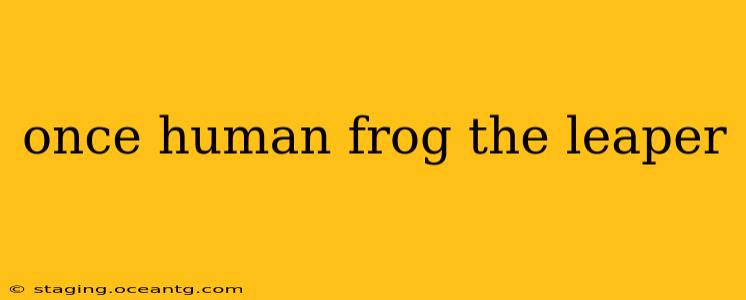Once Human, Now Frog: The Leaper's Extraordinary Tale
The phrase "Once Human, Now Frog: The Leaper's Extraordinary Tale" immediately conjures images of fantasy or perhaps a bizarre scientific experiment. While no documented cases exist of humans transforming into frogs, the concept sparks fascinating questions about metamorphosis, mythology, and the very nature of identity. This exploration delves into the intriguing possibilities and associated queries.
What is the Legend of the Frog Prince?
The most familiar association with humans and frogs is the fairytale of the Frog Prince. This classic story explores themes of transformation, prejudice, and the importance of inner beauty. The frog prince, cursed by a wicked spell, is transformed back into a handsome human prince through a princess's act of kindness. This story, while fictional, highlights the powerful symbolism of transformation and the possibility of change inherent in both the human and animal worlds. It's crucial to remember this story is a fairytale, not a realistic depiction of human-frog transformation.
Are there any documented cases of humans turning into frogs?
No, there are absolutely no documented or scientifically credible cases of humans transforming into frogs. This is biologically impossible. Humans and frogs belong to entirely different classes of vertebrates, with vastly different genetic structures and developmental pathways. The idea is firmly rooted in folklore and fantasy.
What is metamorphosis in animals?
Metamorphosis is a biological process by which an animal physically develops after birth or hatching, involving a relatively abrupt change in the animal's body structure through cell growth and differentiation. This is a common occurrence in insects (like butterflies and dragonflies), amphibians (like frogs and toads), and some other invertebrates. Crucially, this process happens within a species, not between vastly different species like humans and frogs. A tadpole undergoes metamorphosis to become a frog, but a human cannot undergo a similar transformation.
What mythological creatures combine human and frog features?
Various cultures feature mythological creatures with blended human and amphibian attributes. These often symbolize duality, transformation, and the liminal space between the human and natural worlds. Specific examples would depend on the cultural context and mythology being considered. Research into specific mythologies (e.g., those of ancient Egypt, Greece, or various indigenous cultures) would reveal specific examples.
Could science ever make this happen?
Based on our current understanding of biology and genetics, the transformation of a human into a frog is fundamentally impossible. The genetic and developmental differences are far too vast. While genetic engineering is advancing rapidly, it focuses on modifying existing traits within a species rather than creating such a radical trans-species transformation. The concept remains firmly within the realm of science fiction.
What if it were possible? What would be the ethical implications?
Even if such a transformation were hypothetically possible, the ethical considerations would be immense. Such a drastic alteration of a human being raises questions about consent, autonomy, and the very definition of humanity. The potential for misuse and exploitation would be significant, demanding strict ethical guidelines and regulations, even in a purely hypothetical scenario.
In conclusion, the idea of a human transforming into a frog, while captivating in its imaginative potential, remains firmly in the realm of fantasy. Exploring the associated questions, however, offers a fascinating lens through which to consider themes of transformation, mythology, and the ethical boundaries of science. The "Leaper's Extraordinary Tale," therefore, serves as a compelling thought experiment rather than a factual account.
